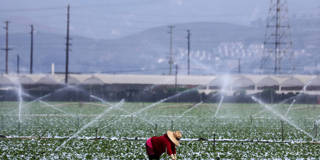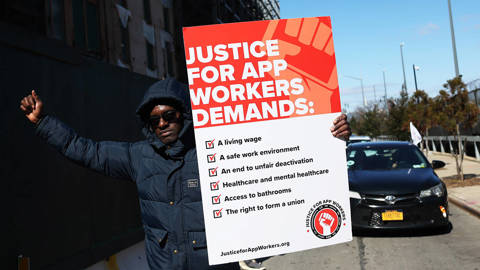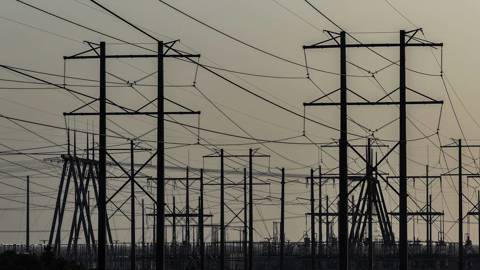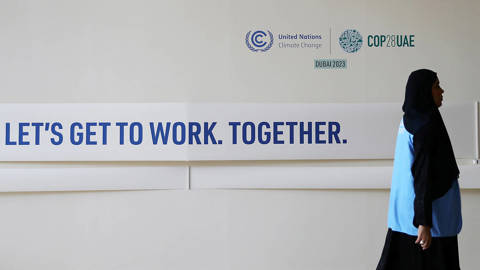Water-related challenges – whether there is too much or too little, or whether it is dirty and unsafe – are already fueling chronic food and health insecurity in entire regions. To safeguard this most fundamental natural resource, we urgently need a new, global strategy to govern water for the common good.
LONDON – The world’s water crisis can no longer be ignored. Unless we manage water properly, we will neither tackle climate change nor meet most of the Sustainable Development Goals (SDGs).
Last year’s unprecedented floods, droughts, cyclonic storms, and heatwaves showed what is coming. But while such disasters garner plenty of attention, the underlying water crisis does not. Water-related challenges – whether there is too much or too little, or whether it is dirty and unsafe – are already fueling chronic food and health insecurity in entire regions. Every 80 seconds, a child under five dies from a disease caused by polluted water; and hundreds of millions more are growing up stunted and with diminished lifetime prospects.
Making matters worse, we have entered a vicious cycle in which the interaction of the water crisis, global warming, and the loss of biodiversity and natural capital exacerbate all three. Wetland erosion and lost soil moisture risk turning some of the planet’s great carbon stores into new sources of greenhouse-gas emissions, with devastating consequences for the climate.
No country can rely on its own territory for more than half the rainfall it receives. Everyone’s fresh water ultimately comes from precipitation, which depends on the presence of stable oceans, intact forests, and healthy ecosystems in other countries and regions. Yet the capacity of both land and ocean systems to generate water is being destabilized.
As co-chairs of the Global Commission on the Economics of Water, we are calling for collective action to overcome the water crisis. We must marshal a response that is bolder, more integrated across sectors, more networked at the national and global levels, and more equitable than previous efforts. Our work shows that this will require a new “economics of water,” as well as a comprehensive strategy to address seven key points.
First, we must recognize the global water cycle as a common good, and manage it accordingly. Since everyone is ultimately connected through water, we must work together to break the vicious cycle and put water back on a sustainable trajectory. That will require a vision based on justice and equity for all communities everywhere.
Second, we must adopt a mission-driven approach encompassing all the key roles that water plays in human well-being. That means treating safe water for domestic use as a human right, and acting collectively to stabilize the global hydrological cycle by managing water use in industry. To ensure food security and resilient food supply chains, and to preserve biodiversity and natural carbon sinks, we will need a revolution in both green (rain-fed) and blue (irrigated) water management.
In addition to mobilizing diverse stakeholders, we will need to use innovation policies and industrial strategies to catalyze solutions to the water crisis. We should scale up investments in water through new public-private partnerships that are as ambitious as those that got us to the moon 50 years ago; but we must attach conditions to ensure that collectively created value is shared widely.
Third, we need to stop underpricing water. With proper pricing and targeted support for the poor, water would be used more efficiently in every sector, more equitably across every community, and more sustainably both locally and globally. But our decision-making also must account for water’s non-economic value, to ensure that we are protecting the broader ecosystem on which the water cycle (and human societies) depend.
Fourth, we must phase out some $700 billion of annual agriculture and water subsidies – which often fuel excessive water consumption and other environmentally damaging practices – and reduce the leakages in today’s water-delivery systems. Doing so would free up significant resources with which to incentivize water conservation and support the poor directly.
Fifth, we should establish Just Water Partnerships (JWPs) to ensure that low- and middle-income countries can invest in water access, resilience, and sustainability, in ways that contribute both to their national development goals and the global common good.
JWPs would help to bring together several financing streams, not only by re-channeling inefficient domestic subsidies toward better uses, but also by enabling multilateral development banks and development-finance institutions to leverage public finance and crowd in more private capital. The economic returns on these investments would vastly exceed their costs, especially if JWPs are designed to maximize synergies with initiatives to address climate change and achieve more inclusive growth.
Sixth, we should support more dynamic innovation to extend the reach of scarce water resources. Again, such investments will yield high returns. Going to the moon produced advances not only in aerospace but also in nutrition, electronics, communications, materials, and software. Likewise, focusing our attention on the water challenge means doing many things differently, which will lead to creative breakthroughs across many sectors.
For example, fortifying freshwater-storage systems will require us to reimagine how we manage wetlands and groundwater resources that have been dangerously depleted. Developing an urban circular (recycling-oriented) economy for water will create a new logic for treating industrial and urban wastewater. Adopting precision irrigation, drought-resilient rain-fed farming, and less water-intensive crops will move us toward more sustainable food systems and higher incomes for farmers. And water footprints in manufacturing can be reduced, including through the reuse of water in producing critical materials such as the lithium we need for widespread electrification.
Lastly, we must reshape multilateral governance for water. The current system is highly fragmented and inadequate to the challenge. One useful tool is trade policy. By incorporating water-conservation standards in trade agreements, we can encourage more sustainable practices and discourage wasteful water subsidies. We also must use multilateralism to develop skills and capacity globally, and to protect the farmers, women, indigenous peoples, and consumers who are at the frontlines of water conservation.
We still have a chance to convert the water crisis into a global opportunity for economy-wide progress and a new social contract with justice and equity at its center. Failing that, we will no longer have a safe Earth system.











LONDON – The world’s water crisis can no longer be ignored. Unless we manage water properly, we will neither tackle climate change nor meet most of the Sustainable Development Goals (SDGs).
Last year’s unprecedented floods, droughts, cyclonic storms, and heatwaves showed what is coming. But while such disasters garner plenty of attention, the underlying water crisis does not. Water-related challenges – whether there is too much or too little, or whether it is dirty and unsafe – are already fueling chronic food and health insecurity in entire regions. Every 80 seconds, a child under five dies from a disease caused by polluted water; and hundreds of millions more are growing up stunted and with diminished lifetime prospects.
Making matters worse, we have entered a vicious cycle in which the interaction of the water crisis, global warming, and the loss of biodiversity and natural capital exacerbate all three. Wetland erosion and lost soil moisture risk turning some of the planet’s great carbon stores into new sources of greenhouse-gas emissions, with devastating consequences for the climate.
No country can rely on its own territory for more than half the rainfall it receives. Everyone’s fresh water ultimately comes from precipitation, which depends on the presence of stable oceans, intact forests, and healthy ecosystems in other countries and regions. Yet the capacity of both land and ocean systems to generate water is being destabilized.
As co-chairs of the Global Commission on the Economics of Water, we are calling for collective action to overcome the water crisis. We must marshal a response that is bolder, more integrated across sectors, more networked at the national and global levels, and more equitable than previous efforts. Our work shows that this will require a new “economics of water,” as well as a comprehensive strategy to address seven key points.
First, we must recognize the global water cycle as a common good, and manage it accordingly. Since everyone is ultimately connected through water, we must work together to break the vicious cycle and put water back on a sustainable trajectory. That will require a vision based on justice and equity for all communities everywhere.
SPRING SALE: Save 40% on all new Digital or Digital Plus subscriptions
Subscribe now to gain greater access to Project Syndicate – including every commentary and our entire On Point suite of subscriber-exclusive content – starting at just $49.99.
Subscribe Now
Second, we must adopt a mission-driven approach encompassing all the key roles that water plays in human well-being. That means treating safe water for domestic use as a human right, and acting collectively to stabilize the global hydrological cycle by managing water use in industry. To ensure food security and resilient food supply chains, and to preserve biodiversity and natural carbon sinks, we will need a revolution in both green (rain-fed) and blue (irrigated) water management.
In addition to mobilizing diverse stakeholders, we will need to use innovation policies and industrial strategies to catalyze solutions to the water crisis. We should scale up investments in water through new public-private partnerships that are as ambitious as those that got us to the moon 50 years ago; but we must attach conditions to ensure that collectively created value is shared widely.
Third, we need to stop underpricing water. With proper pricing and targeted support for the poor, water would be used more efficiently in every sector, more equitably across every community, and more sustainably both locally and globally. But our decision-making also must account for water’s non-economic value, to ensure that we are protecting the broader ecosystem on which the water cycle (and human societies) depend.
Fourth, we must phase out some $700 billion of annual agriculture and water subsidies – which often fuel excessive water consumption and other environmentally damaging practices – and reduce the leakages in today’s water-delivery systems. Doing so would free up significant resources with which to incentivize water conservation and support the poor directly.
Fifth, we should establish Just Water Partnerships (JWPs) to ensure that low- and middle-income countries can invest in water access, resilience, and sustainability, in ways that contribute both to their national development goals and the global common good.
JWPs would help to bring together several financing streams, not only by re-channeling inefficient domestic subsidies toward better uses, but also by enabling multilateral development banks and development-finance institutions to leverage public finance and crowd in more private capital. The economic returns on these investments would vastly exceed their costs, especially if JWPs are designed to maximize synergies with initiatives to address climate change and achieve more inclusive growth.
Sixth, we should support more dynamic innovation to extend the reach of scarce water resources. Again, such investments will yield high returns. Going to the moon produced advances not only in aerospace but also in nutrition, electronics, communications, materials, and software. Likewise, focusing our attention on the water challenge means doing many things differently, which will lead to creative breakthroughs across many sectors.
For example, fortifying freshwater-storage systems will require us to reimagine how we manage wetlands and groundwater resources that have been dangerously depleted. Developing an urban circular (recycling-oriented) economy for water will create a new logic for treating industrial and urban wastewater. Adopting precision irrigation, drought-resilient rain-fed farming, and less water-intensive crops will move us toward more sustainable food systems and higher incomes for farmers. And water footprints in manufacturing can be reduced, including through the reuse of water in producing critical materials such as the lithium we need for widespread electrification.
Lastly, we must reshape multilateral governance for water. The current system is highly fragmented and inadequate to the challenge. One useful tool is trade policy. By incorporating water-conservation standards in trade agreements, we can encourage more sustainable practices and discourage wasteful water subsidies. We also must use multilateralism to develop skills and capacity globally, and to protect the farmers, women, indigenous peoples, and consumers who are at the frontlines of water conservation.
We still have a chance to convert the water crisis into a global opportunity for economy-wide progress and a new social contract with justice and equity at its center. Failing that, we will no longer have a safe Earth system.